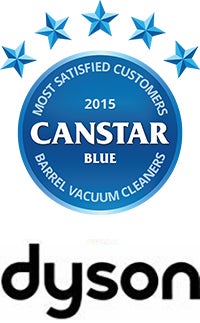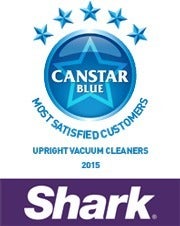2015 Vacuum Cleaner Reviews
Posted by Canstar Blue September 22nd 2016
You are viewing the archived 2015 Ratings for Vacuum Cleaners. For the latest ratings, go to the current barrel vacuum cleaner, or upright vacuum cleaner ratings.
Shoppers from around the country tell us which vacuum cleaner brand they’re most satisfied with in our latest ratings.
Vacuuming is one of life’s little inevitabilities… unless you live outside in the woods, I suppose. To tackle the task of keeping your floors clean, many different types are available to purchase. We’re going to take a closer look at two of the most common types of vacuum cleaner, and reveal what your fellow Kiwis think of the brands they purchased.
Barrel Vacuum Cleaners
 A barrel vacuum is quite conventional, so you’ll probably already be familiar with it. A suction head sits at the end of a ‘hose’, which is itself connected to a unit with wheels that you drag behind you. These units can be quite cheap, and are especially easy to store. And because they’re usually powered by a chord instead of by batteries, they will typically have quite strong suction.
A barrel vacuum is quite conventional, so you’ll probably already be familiar with it. A suction head sits at the end of a ‘hose’, which is itself connected to a unit with wheels that you drag behind you. These units can be quite cheap, and are especially easy to store. And because they’re usually powered by a chord instead of by batteries, they will typically have quite strong suction.
Our survey results reveal that Dyson customers are most satisfied with their barrel vacuum cleaner, which has earned this brand our award for 2015! Dyson excelled in many areas; most notably value for money, ease of use, and effectiveness.
Miele was close behind in the overall satisfaction stakes, with four stars to its name. It also scored five stars for noise. Another standout contender was Nilfisk, five star recipient for vacuum cleaner size.
Upright Vacuum Cleaners
| Brand | Overall satisfaction |
Value for money |
Ease of use |
Noise | Effectiveness of clean |
Size |
|---|---|---|---|---|---|---|
| * Overall satisfaction is an individual rating and not a combined total of all ratings. Brands with equal overall satisfaction ratings are listed in alphabetical order. | ||||||
| Shark | ||||||
| Dyson | ||||||
| Electrolux | ||||||
 These vacuum cleaners have no long hoses, but rather are a standalone unit. They’re tall, don’t need to be pulled behind you as you go, and have wide suction faces so you (potentially) can scoop up more dust at once. Generally speaking, they’re quite easy to manoeuvre, which makes them particularly appealing to those who live in tight spaces.
These vacuum cleaners have no long hoses, but rather are a standalone unit. They’re tall, don’t need to be pulled behind you as you go, and have wide suction faces so you (potentially) can scoop up more dust at once. Generally speaking, they’re quite easy to manoeuvre, which makes them particularly appealing to those who live in tight spaces.
In this category, Shark was #1 for customer satisfaction, edging out a host of well-known competition to receive our award for upright vacuum cleaners.
Also rated were Electrolux and Dyson. Award-winner for barrel vacuums, Dyson, took out a five star rating in the area of vacuum cleaner size, demonstrating the brand delivers great quality products across multiple products.
Frequently asked questions
The basic science behind a vacuum cleaner involves four parts: the suction nozzle, an intake port, back-end motor and air filled vacuum. Most vacuum cleaners work in these three steps:
- The nozzle sucks the dirt from the inside towards intake port.
- The sucking force is caused by the back-end motor which further transfers the dirt to the vacuum.
- Dirt may then be disposed of by taking out the attached disposable bag and filter at the bottom of the vacuum.
There are other vacuum cleaners that are bagless, or have a different way of storing and removing the dirt, but the above is the most common variety.
The earliest form of the vacuum cleaner involved beating woven ropes and rugs onto carpets to take out dust from well-off English households. The earliest attempts of coming up with a mechanical version started during the 1840s up to 1860s.
Hand-operated dirt sweepers
This began with collective rotating brushes which served as dirt sweepers both on the streets and in the home. They were turned by hand and moved towards the direction which needed to be cleaned next. These dirt sweepers were used in home carpets and factories from 1858 to 1876.
Suction based cleaners
In 1901, the second major invention which pivotally routed towards today’s modern vacuum cleaner was born: a suction mechanism as invented by Hubert Cecil Booth.
Booth discovered dirt cannot be fully removed with the use of hand rolled sweeping brushes. He confirmed this when a suctioning machine blew out some deep seated dust at one event demonstration. Soon he came up with a cleaning machine to fit the Buckingham Palace. It did not contain any brushes; all the cleaning was done by suction through long tubes with nozzles on the ends. Large and noisy, it received several complaints but did the job better than ever before.
Despite the success of Booth’s invention, it took several years to develop vacuums to be commercially distributed in homes. The first being the first Model 0 Hoover in England. This led to other machines by Eureka and Electrolux soon following, with the closest resemblance to today’s machine in the 1930s when a lighter, more efficient cleaner made of Bakelite became a household necessity.
With the ingenious development of James Spangler and the enterprising initiatives of William Hoover, the vacuum cleaner had its first attempts towards mass production. When homeowners need to clean their carpets, they’d usually mention they needed to ‘hoover’ their floors or they were ‘hoovering’ at home.
The term ‘vacuum cleaner’ replaced ‘hoovering machine’ as a term for the machine’s standardisation purposes and the vacuum cleaner became a basic in homes across the world.
No home is complete without a vacuum cleaner. This handy machine can efficiently clean the house easily and quickly, in every hard-to-reach corner without having to use a mop or brush. Its nozzles are available in different sizes from barrels and hand sticks to brush heads and more, depending on the angle you’d need to clean. As a modern invention, the vacuum cleaner is now a household item many can’t live without.
While there are numerous formats of vacuum cleaners these days, the following are three of the most common cleaners in the home:
Upright
By its very name, most of this unit’s body may be vertically held up. When used on smooth flooring like timber or tiles, an upright vacuum cleaner is easier to carry and move around because of its size. There’ll be fewer chances for tangled cords since it’s a whole type of appliance, despite some difficulties in reaching tighter corners.
You will need $200 to $500 depending on preferred features’ extent of efficiency and durability. Beyond merely taking out dust, some units feature pollen, fungi and bacterial removers.
Barrel or Canister Contained
This looks bulkier and more tedious to move around with but is actually more agile to use in the more challenging corners of your house like air con vents and railings. Simply insert the hose into a dusty area, and the motor which contains the dust collecting bag and shielding filter should already store the lint for later disposal.
With their moveable hoses and compact motor systems, they’re expected to be much pricier at an average range of $300 to $700.
Handheld
It’s the most portable, battery-operated vacuum you can have to clean car interiors and couches. If the price of an average barrel vacuum cleaner is beyond your budget range, you may combine this item with an upright vacuum. After cleaning up most of a floor’s surface, the hard-to-reach corners may then be thoroughly emptied of dust with this item. Prepare about $85 to $150 to have this device.
Your vacuum’s longevity will depend on the quality of unit you’re investing in and how well you maintain it. Like any appliance, your vacuum cleaner has a set of cleaning and maintenance instructions in its manual. Get familiarised with its directions, so you’ll know which parts can be detached and separately cleaned.
For more information or to see what criteria we used to rate the best vacuum cleaners in Australia, head here.
Canstar Blue commissions Colmar Brunton to regularly survey 2,500 New Zealand consumers across a range of categories to measure and track customer satisfaction. The outcomes reported are the results from customers within the survey group who have purchased a vacuum cleaner in the last 3 years – in this case, 275 New Zealanders who bought an upright model, and 476 who purchased a barrel model.
Each brand must have received at least 30 responses in order to be included. Results are comparative and it should be noted that brands receiving three stars have still achieved a satisfaction measure of at least six out of 10. Not all brands available in the market have been compared in this survey.
